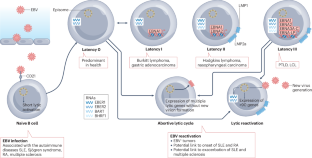Epstein–Barr virus as a potentiator of autoimmune diseases
IF 32.7
1区 医学
Q1 RHEUMATOLOGY
引用次数: 0
Abstract
The Epstein–Barr virus (EBV) is epidemiologically associated with development of autoimmune diseases, including systemic lupus erythematosus, Sjögren syndrome, rheumatoid arthritis and multiple sclerosis. Although there is well-established evidence for this association, the underlying mechanistic basis remains incompletely defined. In this Review, we discuss the role of EBV infection as a potentiator of autoimmune rheumatic diseases. We review the EBV life cycle, viral transcription programmes, serological profiles and lytic reactivation. We discuss the epidemiological and mechanistic associations of EBV with systemic lupus erythematosus, Sjögren syndrome, rheumatoid arthritis and multiple sclerosis. We describe the potential mechanisms by which EBV might promote autoimmunity, including EBV nuclear antigen 1-mediated molecular mimicry of human autoantigens; EBV-mediated B cell reprogramming, including EBV nuclear antigen 2-mediated dysregulation of autoimmune susceptibility genes; EBV and host genetic factors, including the potential for autoimmunity-promoting strains of EBV; EBV immune evasion and insufficient host responses to control infection; lytic reactivation; and other mechanisms. Finally, we discuss the therapeutic implications and potential therapeutic approaches to targeting EBV for the treatment of autoimmune disease. Epstein–Barr virus (EBV) infection is associated with numerous autoimmune diseases, including rheumatic diseases. In this Review, Robinson and colleagues provide an overview of the biology of EBV, the potential mechanisms through which EBV could promote autoimmune diseases and how EBV might be targeted for the treatment of autoimmune disease.


爱泼斯坦-巴氏病毒是自身免疫性疾病的增效剂
从流行病学角度看,爱泼斯坦-巴氏病毒(EBV)与自身免疫性疾病的发病有关,包括系统性红斑狼疮、斯约格伦综合征、类风湿性关节炎和多发性硬化症。尽管有确凿证据表明这种关联,但其潜在的机理基础仍未完全明确。在本综述中,我们将讨论 EBV 感染在自身免疫性风湿病中的作用。我们回顾了 EBV 的生命周期、病毒转录程序、血清学特征和溶解性再活化。我们讨论了 EBV 与系统性红斑狼疮、斯约格伦综合征、类风湿性关节炎和多发性硬化症的流行病学和机理关联。我们描述了 EBV 可能促进自身免疫的潜在机制,包括 EBV 核抗原 1 介导的人类自身抗原分子模拟;EBV 介导的 B 细胞重编程,包括 EBV 核抗原 2 介导的自身免疫易感基因失调;EBV 和宿主遗传因素,包括潜在的自身免疫促进型 EBV 株;EBV 免疫逃避和宿主反应不足以控制感染;溶解性再活化;以及其他机制。最后,我们讨论了针对 EBV 治疗自身免疫性疾病的治疗意义和潜在治疗方法。
本文章由计算机程序翻译,如有差异,请以英文原文为准。
求助全文
约1分钟内获得全文
求助全文
来源期刊

Nature Reviews Rheumatology
医学-风湿病学
CiteScore
29.90
自引率
0.90%
发文量
137
审稿时长
6-12 weeks
期刊介绍:
Nature Reviews Rheumatology is part of the Nature Reviews portfolio of journals. The journal scope covers the entire spectrum of rheumatology research. We ensure that our articles are accessible to the widest possible audience.
 求助内容:
求助内容: 应助结果提醒方式:
应助结果提醒方式:


